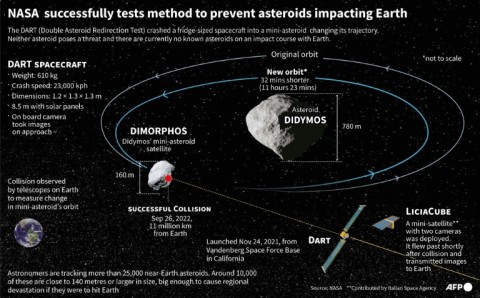PARIS - Europe's Hera probe successfully launched on a mission to inspect the damage done by a NASA spacecraft that smashed into an asteroid during the first test of Earth's planetary defences.
Despite fears that an approaching hurricane could delay the launch, the probe blasted off on a SpaceX rocket into cloudy skies from Cape Canaveral in the US state of Florida just before 11am local time.
Hera's mission is to investigate the aftermath of NASA's Double Asteroid Redirection Test (DART), which deliberately crashed into the Dimorphos asteroid in 2022 roughly 11 million kilometres from Earth.
The fridge-sized DART spacecraft successfully knocked the asteroid well off course, demonstrating that humanity may no longer be powerless against potentially planet-killing asteroids that could head our way.
The European Space Agency (ESA) said that Hera will conduct what it has dubbed a "crime scene investigation".
"Hera will gather the data we need to turn kinetic impact into a well-understood and repeatable technique on which all of us may rely one day," ESA chief Josef Aschbacher said on the agency's broadcast of the launch.

Next year, Hera is planned to get a gravitational boost as it flies past Mars, arriving near Dimorphos in December 2026 to begin its six-month investigation.
Dimorphos, which is actually a moonlet orbiting its big brother Didymos, never posed a threat to Earth.
After DART's impact, Dimorphos shed material to the point where its orbit around Didymos was shortened by 33 minutes -- proof that it was successfully deflected.
Analysis of the DART mission has suggested that rather than being a single hard rock, Dimorphos was more a loose pile of rubble held together by gravity.
"The consequence of this is that, instead of making a crater" on Dimorphos, DART may have "completely deformed" the asteroid, said Hera's principal investigator Patrick Michel.
The mission will be equipped with two nanosatellites.
One will land on Dimorphos and probe inside the asteroid with radar, a first on such an asteroid. The other will study its composition from farther out.
An asteroid wider than a kilometre (-- which could trigger a global catastrophe on a scale that wiped out the dinosaurs -- is estimated to strike Earth every 500,000 years or so.
An asteroid around 140 metres wide -- which is a little smaller than Dimorphos but could still take out a major city -- hits our home planet around every 20,000 years.
There are also no known 140-metre asteroids on a collision course with Earth -- but only 40 percent of those space rocks are believed to have been identified.

